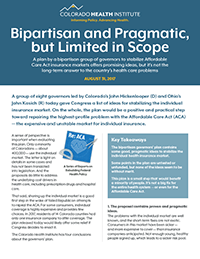A group of eight governors led by Colorado’s John Hickenlooper (D) and Ohio’s John Kasich (R) today gave Congress a list of ideas for stabilizing the individual insurance market.

On the whole, the plan would be a positive and practical step toward repairing the highest-profile problem with the Affordable Care Act (ACA) — the expensive and unstable market for individual insurance.
A sense of perspective is important when evaluating this plan. Only a minority of Coloradans — about 400,000 — use the individual market. The letter is light on details in some cases and has not been translated into legislation. And the proposals do little to address the underlying cost drivers in health care, including prescription drugs and hospital care.
That said, shoring up the individual market is a good first step in the wake of failed Republican attempts to repeal the ACA. For some consumers, individual coverage is highly expensive and provides few choices. In 2017, residents of 14 Colorado counties had only one insurance company to offer coverage. The plan released today would likely offer some relief if Congress decides to enact it.
The Colorado Health Institute has four conclusions about the governors’ plan.
1. The proposal contains proven and pragmatic ideas.

CHI's research
on ACA
repeal.
The problems with the individual market are well known, and the short-term fixes are not exotic. Consumers in this market have been sicker — and more expensive to cover — than insurance companies anticipated. Not enough young, healthy people signed up, which leads to a sicker risk pool. The federal government has also failed to deliver on several funding promises to bolster insurers in the first few years of the ACA. As a result, prices are high and some insurance companies have exited the market. A few points in the governors’ plan would be likely to help address these problems:
- Keep the individual mandate. It’s unpopular, but the requirement for most people to buy health insurance is necessary in order to keep other popular parts of the law — namely the ban on insurance companies discriminating against customers with pre-existing health conditions.
- Fund cost-sharing reduction (CSR) payments through 2019. The federal government makes CSR payments to insurance companies to bring down out-of-pocket cost for lower income customers. A lawsuit and mixed signals from the Trump administration have kept insurers guessing each month about whether they will receive CSR payments. The Kaiser Family Foundation estimates that uncertainty over CSRs has driven price increases of 1 percent to 20 percent for coverage in 2018.
2. Some of the proposal’s ideas are untested.
Other concepts show promise, but they have not been used in the real world and the evidence for them does not yet exist.
- Expanding choice through the federal employee health plan. Under the proposal, residents of counties with just one insurer on the individual marketplace would be able to buy into the health insurance plan for federal employees. It’s an idea worth exploring, but we have no way to know how the insurance companies that run the federal plan would react. Customers from the individual market are likely to bring a very different risk pool from federal employees. The idea seems to be a compromise position. Some Democrats have advocated for allowing people in underserved counties to buy in to Medicaid or Medicare, while Republicans tend to prefer private market options.
- Allowing states to create alternative essential health benefits. Conservatives have blamed the ACA’s essential health benefits for driving up the cost of insurance. Giving states more flexibility to determine benefits could possibly reduce costs, although large (and unpopular) benefit cuts would be needed to dramatically reduce costs.
3. Some of the ideas are good but unfunded.
Some of the best ideas require an upfront infusion of money, and it’s unclear how or whether Congress would fund them.
- Creating a $15 billion annual state stability fund. This is one of the ideas to come out of Republican bills to repeal the ACA. The pot of money would give states funding to deal with high-cost customers. Colorado would likely use the money for a reinsurance plan that the state Division of Insurance is studying this summer. Alaska created such a system and successfully brought down premiums on its individual market. However, when Republicans proposed the idea this year, they planned to fund it by cutting Medicaid. The governors’ plan keeps Medicaid intact and does not identify a source of cash for the stability fund. (It’s worth mentioning the idea could save some money by reducing premium prices, which also would reduce tax credits the federal government gives to individual market customers. This was Alaska’s successful argument.)
- Fixing the family glitch. This is a problem with the original drafting of the ACA. It forbids some families from getting tax credits because one family member is offered affordable coverage at work. However, the ACA does not take into account whether the coverage is “affordable” for the whole family — only the individual worker. As a result, some families — especially lower income workers— can’t receive subsidized coverage. Fixing this glitch seems like an obvious step, but it could cost up to $6.5 billion a year, according to the Urban Institute.
4. It’s a Band-Aid, not a heart transplant.
Finally, it’s important to keep a sense of perspective about what this plan would do and wouldn’t do. The proposal would address problems with part of the ACA. It would not bring down health costs or improve care dramatically for the country as a whole. Some topics the proposal does not address:
- Groups left behind by the ACA. People have a hard time affording insurance when they make a little too much to qualify for the ACA’s main benefits — Medicaid or subsidized coverage on the private market. Medicaid eligibility ends for single workers who make about $16,000 a year, and this group struggles to afford private coverage even with generous ACA subsidies. The ACA’s tax credits don’t apply to single workers earning more than $48,000. This wage puts people firmly in the middle class, but in some regions, premiums can be as high as $500 a month for an individual and much more for families. The governors’ plan does not expand the range of people who qualify for ACA benefits.
- The cost of drugs and hospital care. Two of the largest cost drivers in the U.S. health system are prescription drugs and hospitals. The governors’ proposal calls for a move to “value-based payments,” which would give providers an incentive to keep costs low while keeping their patients healthy. But the proposal is short on specifics and does not offer the promise of immediate changes.
- The future of Medicaid. Costs for this program are projected to become an ever-larger part of federal and state budgets. The bill to repeal the ACA addressed the cost problem by reducing eligibility and shifting the risk for higher costs to the states. These ideas would have left millions uninsured and would likely have harmed rural hospitals. However, the long-term problem presented by the Medicaid budget is still with us. The governors’ proposal does not address Medicaid at all, nor does it mention the Medicare program.
On the whole, the proposal spearheaded by Governors Hickenlooper and Kasich provides some pragmatic, workable ideas to address a pressing problem in the individual health care market. It should not be viewed as a solution for everything that’s broken in American health care. It’s a good start, but it’s only a first step.

